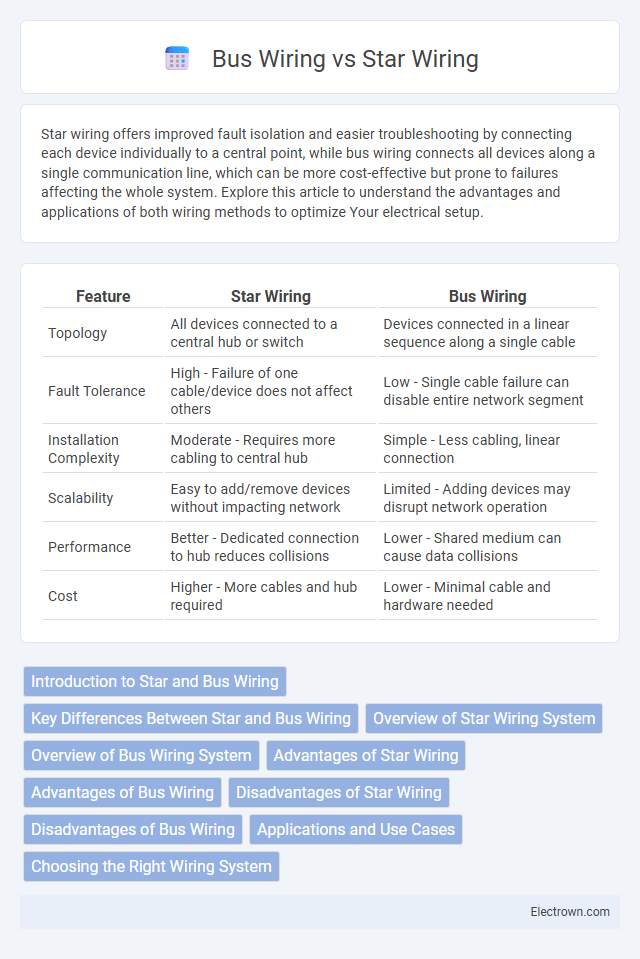Star wiring offers improved fault isolation and easier troubleshooting by connecting each device individually to a central point, while bus wiring connects all devices along a single communication line, which can be more cost-effective but prone to failures affecting the whole system. Explore this article to understand the advantages and applications of both wiring methods to optimize Your electrical setup.
Table of Comparison
| Feature | Star Wiring | Bus Wiring |
|---|---|---|
| Topology | All devices connected to a central hub or switch | Devices connected in a linear sequence along a single cable |
| Fault Tolerance | High - Failure of one cable/device does not affect others | Low - Single cable failure can disable entire network segment |
| Installation Complexity | Moderate - Requires more cabling to central hub | Simple - Less cabling, linear connection |
| Scalability | Easy to add/remove devices without impacting network | Limited - Adding devices may disrupt network operation |
| Performance | Better - Dedicated connection to hub reduces collisions | Lower - Shared medium can cause data collisions |
| Cost | Higher - More cables and hub required | Lower - Minimal cable and hardware needed |
Introduction to Star and Bus Wiring
Star wiring topology connects each device directly to a central hub, ensuring dedicated communication lines that reduce data collisions and improve network reliability. Bus wiring topology links all devices along a single shared cable, allowing data to travel bidirectionally but increasing the risk of collision and network downtime. Star wiring offers better fault isolation compared to bus wiring, making it more suited for modern, scalable network infrastructures.
Key Differences Between Star and Bus Wiring
Star wiring features a central hub connecting individual devices with dedicated cables, enhancing fault isolation and simplifying troubleshooting, while bus wiring uses a single continuous cable to link all devices, making it easier and cheaper to install but more prone to network failure if the cable is damaged. Star wiring typically supports higher speeds and better performance in modern networks, whereas bus wiring is more common in legacy or simpler setups due to its straightforward design. The central point in star wiring allows for easier addition or removal of devices without disrupting the whole system, unlike bus wiring where any break affects the entire network.
Overview of Star Wiring System
Star wiring system consists of a central hub, typically a distribution panel, from which individual cables run directly to each electrical device or outlet. This configuration improves fault isolation since a failure in one cable does not affect the entire network, enhancing overall system reliability. Star wiring also simplifies troubleshooting and allows for easy expansion or modification of the electrical layout.
Overview of Bus Wiring System
Bus wiring system features a single communication line shared by multiple devices, allowing data transmission in a linear path. It simplifies installation and reduces cable usage, ideal for small to medium networks but can suffer from data collisions and troubleshooting challenges. Reliability depends on proper termination at both ends to prevent signal reflections and maintain network integrity.
Advantages of Star Wiring
Star wiring offers superior fault isolation, meaning that if one connection fails, the rest of the network remains unaffected, ensuring higher system reliability. It simplifies troubleshooting and maintenance because each device is connected to a central hub, making it easier to identify and fix issues. Your network benefits from improved performance and scalability since star wiring supports higher data transfer speeds and allows easy addition of new devices without disrupting the overall system.
Advantages of Bus Wiring
Bus wiring offers a simplified and cost-effective network layout by connecting all devices along a single cable, reducing the amount of cabling required. This topology allows easy expansion and troubleshooting since new nodes can be added or removed without disrupting the entire system. Bus wiring also minimizes cable clutter, making it ideal for small networks or environments with limited space.
Disadvantages of Star Wiring
Star wiring can lead to increased cable length and higher installation costs due to the need for individual cable runs from each device to a central hub. Network performance may be affected if the central hub fails, causing a complete system outage. Troubleshooting can become complex as diagnosing the exact point of failure requires careful inspection of both the hub and individual cable connections.
Disadvantages of Bus Wiring
Bus wiring suffers from signal degradation and collision issues due to shared communication lines, limiting network speed and efficiency. Troubleshooting and isolating faults can be challenging because a single cable failure may disrupt the entire network. Scalability is also restricted, making bus wiring less suitable for large or complex network architectures.
Applications and Use Cases
Star wiring is commonly used in residential and commercial buildings for network setups and electrical distribution, offering centralized control and easier fault isolation. Bus wiring is ideal for simple, low-cost systems like home audio setups and small industrial automation, where fewer cables and straightforward installation are priorities. Your choice depends on the complexity and scalability needs of the application, with star wiring supporting larger, more complex networks while bus wiring suits basic, linear configurations.
Choosing the Right Wiring System
Choosing the right wiring system depends on your network size, budget, and performance needs, with star wiring offering centralized control and easier troubleshooting by connecting each device to a central hub. Bus wiring is cost-effective for smaller setups, running a single cable to which all devices connect sequentially but can suffer from signal degradation and is harder to isolate faults. Evaluate your infrastructure requirements to ensure your choice supports scalability, reliability, and maintenance efficiency.
Star Wiring vs Bus Wiring Infographic

 electrown.com
electrown.com